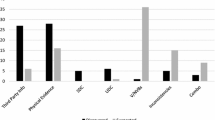Abstract
Conceptual issues about deceit, in specific why lies fail and when and how behavior may betray a lie, provides the basis for considering the type of experimental situations which may be fruitful for the study of deceit. New evidence, integrating past reports with new unpublished findings, compare the relative efficacy of facial, bodily, vocal, paralinguistic and textual measures in discriminating deceptive from honest behavior. The findings show also that most people do not rely upon the most useful sources of information in judging whether someone is lying.
Similar content being viewed by others
References
Davidson, R.J., Ekman, P., & Friesen, W.V. (1988)Emotional expression and brain physiology I: Approach/withdrawal and cerebral asymmetry. Manuscript submitted for publication.
DePaulo, B., Lanier, K., & Davis, T. (1983) Detecting the deceit of the motivated liar.Journal of Personality and Social Psychology, 45 1096–1103.
DePaulo, B.M., Stone, J.I., & Lassiter, G.D. (1985) Deceiving and detecting deceit. In B.R. Schlenker (Ed.)The self and social life (pp. 323–370). New York: McGraw-Hill.
Ekman, P. (1972) Universals and cultural differences in facial expressions of emotion. In J. Cole (Ed.)Nebraska symposium on motivation (pp. 207–283). Lincoln: University of Nebraska Press.
Ekman, P. (1985).Telling lies: Clues to deceit in the marketplace, marriage, and politics. New York: W.W. Norton.
Ekman, P. (1989). The argument and evidence about universals in facial expressions of emotion. In H. Wagner & A. Manstead (Eds.),Handbook of social psychophysiology. Chichester: John Wiley, Ltd.
Ekman, P., Davidson, R., & Friesen, W.V. (1988).Emotional expression and brain physiology II: Duchenne's smile. Manuscript submitted for publication.
Ekman, P. & Friesen, W.V. (1969a) The repertoire of nonverbal behavior: Categories, origins, usage, and coding.Semiotica, 1 49–98.
Ekman, P., & Friesen, W.V. (1969b). Nonverbal leakage and clues to deception.Psychiatry, 32 88–105.
Ekman, P., & Friesen, W.V. (1974) Detecting deception from body or face.Journal of Personality and Social Psychology, 29 288–298.
Ekman, P., & Friesen, W.V. (1978).Facial action coding system. Palo Alto, California: Consulting Psychologists Press.
Ekman, P., Friesen, W.V., & Ancoli, S. (1980). Facial signs of emotional experience.Journal of Personality and Social Psychology, 39(6), 1125–1134.
Ekman, P., Friesen, W.V., O'Sullivan, M., & Scherer, K.R. (1988).Behavioral measurement can distinguish when someone is lying. Manuscript in preparation.
Ekman, P., Friesen, W.V., & Scherer, K.R. (1976). Body movement and pitch in deceptive interaction.Semiotica, 16 23–37.
Miller, K.U., & Tesser, A. (1988) Deceptive behavior in social relationships: a consequence of violated expectations.Journal of Psychology, 122 263–273.
O'Sullivan, M., Ekman, P., Friesen, W.V., & Scherer, K.R. (1988).Which is more important in judging others: Behavior, channel or situation? Manuscript in preparation.
Riggio, R.E., & Friedman, H.S. (1983) Individual differences and cues to deception.Journal of Personality and Social Psychology, 45 899–915.
Scherer, K.R. (1982) Methods of research on vocal communication: paradigms and parameters. In K.R. Scherer & P. Ekman (Eds.),Handbook of methods in nonverbal behavior research (pp. 136–198). Cambridge: Cambridge University Press.
Streeter, L.A., Krauss, R.M., Geller, V., Olson, C. & Apple, W. (1977) Pitch changes during attempted deception.Journal of Personality and Social Psychology, 35 345–350.
Author information
Authors and Affiliations
Additional information
The information reported here also appears inCredibility Assessment—A Unified Theoretical and Research Perspective, J. Yuille (Ed.), in press, Kluwer. The work described was supported by a Research Scientist Award from the National Institute of Mental Health (MH 06092) and a previous grant from NIMH (MH11976).
Rights and permissions
About this article
Cite this article
Ekman, P. Lying and nonverbal behavior: Theoretical issues and new findings. J Nonverbal Behav 12, 163–175 (1988). https://doi.org/10.1007/BF00987486
Issue Date:
DOI: https://doi.org/10.1007/BF00987486




